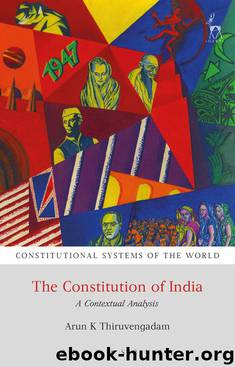The Constitution of India by Arun K Thiruvengadam

Author:Arun K Thiruvengadam
Language: eng
Format: epub
Publisher: Hart Publishing Ltd
Published: 2017-12-15T00:00:00+00:00
V.THE CRISIS OF BACKLOG AND DELAY IN THE INDIAN JUDICIARY
The gridlock between the Modi Government and the judiciary has drawn attention to a looming crisis in the Indian judicial system which has been simmering for decades and now threatens to spill out of control. The Indian judiciary handles the largest number of cases in the world and also experiences some of the longest delays and backlogs. Some statistics will bear out these claims.
The Indian judiciary as a whole consists of about 12,000 courts. Below the Supreme Court are arraigned 24 High Courts, 3,150 District courts, 4,816 munsif/magistrate courts and 1,964 class II magistrate and equivalent courts. The total number of cases before the judicial system has been growing steadily since the colonial era. To begin at the top, the Supreme Court of India has a superior managerial capacity to handle backlog and delay. In 1950 the number of cases pending before the Supreme Court was only 771. By 1978 that number had grown to 23,092, crossing 100,000 in 1983. Following a series of measures, this number came down to as low as 19,806 in 1998 but has continued to increase thereafter, standing at 60,938 as of September 2016.61 This is an extraordinary increase within a single court. The Supreme Court has generally been better than the rest of the judicial hierarchy in handling its backlog.
The crisis has been much more severe in the High Courts and lower judiciary. At the first conference of Chief Ministers held in 1957, Prime Minister Nehru reported that the total number of arrears in the entire judicial system was 164,000 cases.62 By 1982 that number had swelled to 600,000 within only the High Courts and Supreme Court. As of March 2013 the total number of cases had reached a colossal 31.39 million: 64,330 in the Supreme Court, 4.5 million in the 24 High Courts, and 26.83 million in the district and subordinate courts.63 The backlog has also resulted in long delays. News reports of cases being decided nearly 20 years after they were instituted are becoming distressingly common.
It is important to recognise that delay and backlog were a problem even during the colonial period, as is evident from a perusal of the 1924 report of the Justice Rankin Commission. However, it is clear that the constitutional scheme contributes to the much bigger scale of the problem now. The vast jurisdiction of the Supreme Court is certainly a contributing factor to its massive backlog. Added to this is the unanticipated consequence of adopting a provision such as Article 136: special leave petitions under this single provision count, astonishingly, for a very large proportion of cases before the Supreme Court. Other factors that contribute to this problem are the lack of training of judges and other personnel to people the vast judicial system, the low judge-to-population ratio in India when compared with other countries, and the lack of incentives which restrain the best lawyers from taking up positions as judges.
As efforts to reform the Indian legal and
Download
This site does not store any files on its server. We only index and link to content provided by other sites. Please contact the content providers to delete copyright contents if any and email us, we'll remove relevant links or contents immediately.
| Arms Control | Diplomacy |
| Security | Trades & Tariffs |
| Treaties | African |
| Asian | Australian & Oceanian |
| Canadian | Caribbean & Latin American |
| European | Middle Eastern |
| Russian & Former Soviet Union |
The Secret History by Donna Tartt(18840)
The Social Justice Warrior Handbook by Lisa De Pasquale(12141)
Thirteen Reasons Why by Jay Asher(8792)
This Is How You Lose Her by Junot Diaz(6781)
Weapons of Math Destruction by Cathy O'Neil(6142)
Zero to One by Peter Thiel(5684)
Beartown by Fredrik Backman(5594)
The Myth of the Strong Leader by Archie Brown(5423)
The Fire Next Time by James Baldwin(5247)
How Democracies Die by Steven Levitsky & Daniel Ziblatt(5127)
Promise Me, Dad by Joe Biden(5087)
Stone's Rules by Roger Stone(5026)
A Higher Loyalty: Truth, Lies, and Leadership by James Comey(4842)
100 Deadly Skills by Clint Emerson(4840)
Rise and Kill First by Ronen Bergman(4701)
Secrecy World by Jake Bernstein(4643)
The David Icke Guide to the Global Conspiracy (and how to end it) by David Icke(4624)
The Farm by Tom Rob Smith(4434)
The Doomsday Machine by Daniel Ellsberg(4415)
